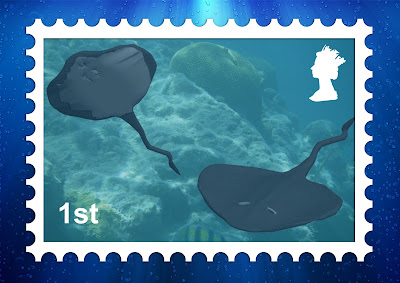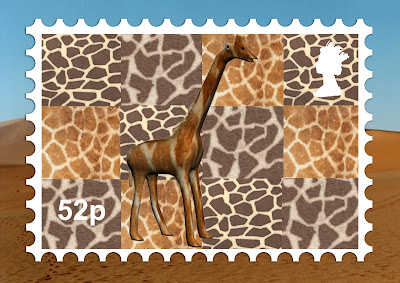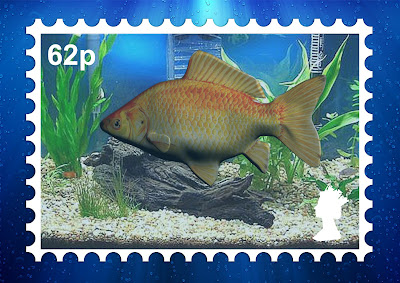

I believe that they all have good bits and I feel that with a lot more time and experiance using 3DS Max they could be improved.
I had never used 3DS Max or any form of 3D software but have enjoyed it lots and cannot wait to start using it again in Semester 2. At the beginning of the course I was a bit worried and a bit dumbstruck because there are so many different options and tools. After looking at a few online tutorials and attending Richard's lectures I began to get a lot more confident with the software and was able to produce some pretty good work.
Thanks for reading my blog of my first semester using 3DS Max.














 I used the Internet to find an image of a stingray's skin that I could use on my model. Below is the texture that I found.
I used the Internet to find an image of a stingray's skin that I could use on my model. Below is the texture that I found.
 I then added the material to my Stingray and I was extremely impressed with how it looked. I played about with the amount of texture that covered over the white colour on the bottom of the stingray. I just kept editing the amounts until I was happy with how it looked.
I then added the material to my Stingray and I was extremely impressed with how it looked. I played about with the amount of texture that covered over the white colour on the bottom of the stingray. I just kept editing the amounts until I was happy with how it looked.

 This is my final Skin for the Stingray that DOES have a Bump on it. I think it looks tonnes better and makes the model look more realistic.
This is my final Skin for the Stingray that DOES have a Bump on it. I think it looks tonnes better and makes the model look more realistic.





 My second attempt was a lot better and would allow me to move onto the next stage when it was completed.
My second attempt was a lot better and would allow me to move onto the next stage when it was completed. I was now going to work on the back fin. I used the vertices and lines at the back end of the body and started to extrude them across the fin giving me some more Polygons to work with. I then edited the vertices over the top of the image to get the correct shape.
I was now going to work on the back fin. I used the vertices and lines at the back end of the body and started to extrude them across the fin giving me some more Polygons to work with. I then edited the vertices over the top of the image to get the correct shape.

 I then continued with making the outline of the fish and moved onto the top fin. I used the same process as the back fin to create the shape. I then moved onto the over two fins in the same way.
I then continued with making the outline of the fish and moved onto the top fin. I used the same process as the back fin to create the shape. I then moved onto the over two fins in the same way.









 I pretty much had now completed my Unwrap and was able to add it to my fish. Ive added this image at this stage below and I think it looks superb even with my original doubts.
I pretty much had now completed my Unwrap and was able to add it to my fish. Ive added this image at this stage below and I think it looks superb even with my original doubts.
 When I had previously done all of my unwraps, my eyes were still in place so there were some polygons missing from the overall shape to make room for them. When I placed the whole fish image on top of the Unwrap firstly there was going to be a random gap where the polygons had made way for the eye socket and secondly my fish was now going to have 4 eyes, the 2 that i created and the 2 from the image placed on top). I tried going back to the original model and deleting the eyes and eyesocket and returning it to its normal state. Unfortuantely in doing this I had to basically delete my UV Unwrap. When I tried to go backk to my map, it had been reset with the new shape and I was going to have to re-do all of the unwrapping. At this point I had to consider what would be best with the short time I had left.
When I had previously done all of my unwraps, my eyes were still in place so there were some polygons missing from the overall shape to make room for them. When I placed the whole fish image on top of the Unwrap firstly there was going to be a random gap where the polygons had made way for the eye socket and secondly my fish was now going to have 4 eyes, the 2 that i created and the 2 from the image placed on top). I tried going back to the original model and deleting the eyes and eyesocket and returning it to its normal state. Unfortuantely in doing this I had to basically delete my UV Unwrap. When I tried to go backk to my map, it had been reset with the new shape and I was going to have to re-do all of the unwrapping. At this point I had to consider what would be best with the short time I had left.













 After a bit of disappointment with the bushy tail, I now moved onto the texturing and materials of the Giraffe. I had seen that classmates had started to look into using a UV Unwrap to complete their textures. As this was my first model in 3ds Max, I decided that I would simply stick to adding materials. I looked on the Internet for a nice image of a Giraffe skin and added it to my maters. I played about with a few of the settings to get it how I wanted it to look. I then added a bump map of the same image to make it look more detailed, which in my opinion it did make a big difference.
After a bit of disappointment with the bushy tail, I now moved onto the texturing and materials of the Giraffe. I had seen that classmates had started to look into using a UV Unwrap to complete their textures. As this was my first model in 3ds Max, I decided that I would simply stick to adding materials. I looked on the Internet for a nice image of a Giraffe skin and added it to my maters. I played about with a few of the settings to get it how I wanted it to look. I then added a bump map of the same image to make it look more detailed, which in my opinion it did make a big difference.


 So there is my final render of my Giraffer. Formy first model in 3ds max of this standard, I was extremely happy with how it turned out. More detail could be put into the amterials to get a wider range on the animal. I think the hair works well on the back of the Giraffe but I was very annoyed about the tail. Oh well, I guess thats life.........
So there is my final render of my Giraffer. Formy first model in 3ds max of this standard, I was extremely happy with how it turned out. More detail could be put into the amterials to get a wider range on the animal. I think the hair works well on the back of the Giraffe but I was very annoyed about the tail. Oh well, I guess thats life.........